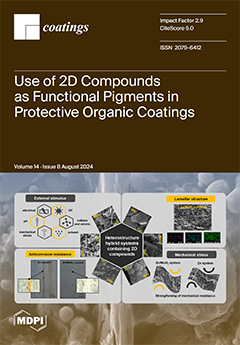This work presents the results of research on the effect of a pulsed plasma treatment on the structure, phase composition, hardness, roughness, and elemental composition of Fe-TiB
2-CrB
2-based coatings. The Fe-TiB
2-CrB
2 coating was applied via the detonation
[...] Read more.
This work presents the results of research on the effect of a pulsed plasma treatment on the structure, phase composition, hardness, roughness, and elemental composition of Fe-TiB
2-CrB
2-based coatings. The Fe-TiB
2-CrB
2 coating was applied via the detonation method. Fe-TiB
2-CrB
2 powder mixtures were used for coating on AISI 1017 steel substrate with the coating surface being modified using a pulsed plasma treatment. The effects of the pulsed plasma treatment on the microstructure, phase composition, and mechanical properties of Fe-TiB
2-CrB
2 detonation coatings were investigated using an optical microscope, X-ray diffraction (XRD), scanning electron microscopy (SEM), a nanohardness tester, and a Leica 3D profilometer. The mechanical test results showed that the hardness of the Fe-TiB
2-CrB
2 coating increased from 8.22 Gpa to 15.6 GPa after the pulsed plasma treatment. The results of the tribological tests show that after the pulsed plasma treatment of Fe-TiB
2-CrB
2 coatings, a wear-resistant modified layer consisting of (Ti,Cr)B
2 and alpha-Fe formed on its surface. It is determined that the surface modified coating layer has a low porosity compared to the coating base. In addition, it is determined that after the pulsed plasma treatment, a decrease in the average pore size is observed in the subsurface layer of the coating. The pulsed plasma treatment resulted in a decrease in the roughness parameter (R
a) from 12.2 μm to 6.6 μm, which is due to the melting of protruding particles.
Full article





